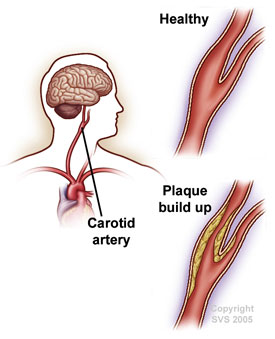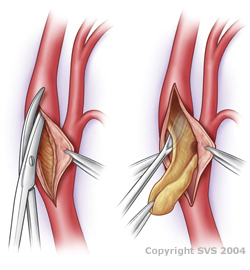Carotid Artery Disease: Stenting & Endarterectomy
Carotid Artery Disease

The carotid arteries are two large arteries that travel from the upper chest through the entire length of the neck and then enter the base of the skull to supply blood flow to the brain. They are the main source of oxygentated blood supply to the brain tissue. Carotid artery disease is a condition in which these arteries become narrowed or blocked as the result of atherosclerosis (hardening of the arteries) with plaque build-up. When the arteries become narrowed, the condition is called carotid artery stenosis. This condition can cause stroke or “mini-strokes.” Minor strokes are referred to as Transient Ischemic Attacks, or TIAs. When carotid artery disease is diagnosed, it is important that you get evaluated by a vascular surgeon to discuss all of your potential treatment options.
Causes of Carotid Artery Disease
Carotid artery disease occurs when sticky, fatty substances called plaque build up in the inner lining of the arteries. See: Atherosclerosis (hardening of the arteries)
The plaque may slowly block or narrow the carotid artery or cause a clot (thrombus) to form. Small pieces of the plaque can also potentially dislodge from the carotid artery and float up into the brain. Both blood clots and floating pieces of plaque can lead to strokes occurring.
Risk factors for blockage or narrowing of the arteries include:
- High blood pressure
- Diabetes
- Heart disease
- High cholesterol
- High triglycerides or lipids
- Heavy tobacco use
- History of peripheral artery disease
- Kidney disease, especially when dialysis is needed
- Family history of stroke or plaque build-up
- Family history of heart disease
- Increasing age
- Previous radiation therapy to the head, neck, or chest
Smoking is a major risk factor for carotid artery disease. Smoking accelerates the rate of plaque buildup dramatically. Smoking increases the risk of most types of stroke. People who smoke one pack a day have over two times the risk of stroke compared to nonsmokers.
Other less common conditions, such as fibromuscular dysplasia (abnormal growth or development of the cells in the walls of carotid arteries) may also cause narrowing of the carotid arteries.
Symptoms of Carotid Stenosis
You may not have any symptoms until the blockage reaches a severe level and causes a stroke or mini-stroke. Many people are diagnosed with carotid stenosis by ultrasound screening before the plaque causes a stroke. These silent plaques can be just as dangerous, as they can unpredictably lead to strokes occurring.
You may have symptoms of a stroke or a transient ischemic attack (TIA). Some of these symptoms include:
- Weakness in one part of your body, often arms or legs on one side
- Sudden loss of vision
- Blurred vision
- Confusion or cognitive dysfunction
- Loss of memory
- Problems with speech and language
- Difficulty with swallowing
- Loss of sensation or numbness of a body part
- Difficulty with walking
- Passing out or feeling very dizzy
- Drooping of the face or facial weakness
Diagnosis of Carotid Artery Blockage
An ultrasound of your neck blood vessels is the most common way that carotid artery disease is identified. Your health care provider will perform a physical exam and take a history to assess your risks. The health care provider may hear an abnormal sound called a bruit within the area of the neck or chest when using a stethoscope to listen to the blood flow in your neck.
A physical exam of the retina of the eyes may also reveal evidence of abnormal clots or plaque particles in the blood vessels of the eye. If you have had a stroke or TIA, a neurological exam will often unconver other problems.
The following tests may be done in the doctors office:
- Blood tests to check cholesterol and triglycerides
- Blood sugar (glucose) blood test
- Blood pressure and pulse evaluation
- Ultrasound of the carotid arteries (carotid duplex or doppler study) to see how well blood is flowing through the carotid artery
The following imaging tests may also be used to examine the blood vessels in the neck and brain in more detail:
- Magnetic resonance angiography (MRA)
- Computerized tomographic angiography (CTA)
- Carotid or cerebral angiography
Treatment of Carotid Artery Disease
Depending on the severity of the narrowing or stenosis, you may require a carotid stent procedure or a surgery called carotid endarterectomy. If the blockage is not considered critical, then it may be managed conservatively with medical management and close surveillance. Aspirin therapy and a “statin” drug are typically indicated.
Non surgical treatment options include:
- Checking your carotid artery with ultrasound testing every year
- Medicine and diet to lower your cholesterol and lipids and control your blood pressure
- Blood-thinning medicines to lower your risk of stroke; some of these medicines are aspirin , clopidogrel (Plavix), Aggrenox, and warfarin (Coumadin).
Carotid Stenting

Carotid stenting involves initially placing a small catheter into the femoral artery in the groin through a small puncture in the skin. The catheter is then guided into the neck under x-ray guidance. X-ray dye is injected through the catheter to take pictures of the artery (a procedure called an angiogram). Then a stent (a collapsed piece of metal rolled into a small straw-shaped tube) is inserted through the catheteter under x-ray guidance and then deployed into the artery at the site of the plaque narrowing, pushing the plaque to the side of the artery and returning the blood flow to a normal level.
Carotid Endarterectomy Surgery

Carotid surgery, known as carotid endarterectomy, is one of the most common surgical procedure used to remove the buildup of plaque from the carotid arteries. It significantly reduces the incidence of new strokes occurring in persons with critical blockages in their neck carotid arteries. It involves the vascular surgeon making an incision on the front of the neck to directly remove the plaque (See image on right). The surgery is most typically performed under general anesthesia and it takes the vascular surgeon between one to two hours to perform. A special type of blood vessel shunt is used to route blood flow around the carotid artery blockage to the brain while the procedure is being performed, therefore minimizing risks during the surgery.
Prognosis with Carotid Stenosis
Carotid stenosis is a condition that can be successfully treated with surgery or stents. With appropriate treatment, patients can significantly reduce their risk of complications such as TIA or stroke.
Without treatment, carotid stenosis can often lead to stroke. Stroke is a leading cause of death in the United States. Some people who have a stroke recover most or all of their functions. Others die from the stroke itself or from complications. About half of those who have a stroke have long-term problems.
Stroke Prevention and Carotid Artery Stenosis
The major complication associated with carotid artery disease are:
- Transient ischemic attack (TIA). This is an episode in which a person has stroke -like symptoms for less than 24 hours, usually less than 1-2 hours. A TIA is often considered a warning sign that a stroke may happen in the future if something is not done to prevent it.
- Stroke. A stroke can happen when a blood vessel in any part of the brain is blocked. The blood through the narrowed carotid artery may slow so much that a clot forms. A stroke may also occur if a small piece of a blood clot or plaque breaks off and travels to the brain.
Carotid Artery Disease Treatment can significantly reduce your risk of developing a TIA or stroke.
Calling your health care provider
Call our vascular clinic at (512) 339-9100 if you are interested in evaluation of your carotid stenosis or if you wish to undergo ultrasound screening to look for the condition.
Go to the emergency room or call the local emergency number (such as 911) if you have symptoms concerning for a stroke. When having a stroke, every second of delay can result in more brain injury.
Prevention of Stroke
The following can help prevent a stroke:
- Avoid fatty foods. Follow a healthy, low-fat diet.
- Do not drink more than 1 to 2 alcoholic drinks a day.
- Exercise regularly if possible: 30 minutes a day if you are not overweight; 60 – 90 minutes a day if you are overweight.
- Quit smoking. Seek medical advice if you are having difficulty with quitting on your own, as there are many medical options available to assist the cesssation process
- Get your blood pressure checked every 1 – 2 years, especially if high blood pressure runs in your family. If you have high blood pressure, heart disease, or have had stroke, you need to have it checked more often. Ask your doctor.
- Attempt to keep your blood pressure close to a normotensive range. If you have other health conditions or have had a prior stroke, you may need to strive for different blood pressure range. Ask your doctor what your ideal blood pressure reading should be.
- Adults should have their cholesterol and triglycerides checked at least every 5 years and treated, if needed. If you have been treated for high cholesterol, you will need it checked more often.
- If you have diabetes, heart disease, or hardening of the arteries somewhere else in your body in addition to your carotid arteries, your LDL “bad” cholesterol should be lower than 70 mg/dL. If only your carotid arteries are affected, a target range would be under 100 mg/dL
- If you have known diabetes, do regular glucose monitoring and periodic Hemoglobin A1c monitoring, and keep your blood sugars under tight control daily
- Visit with your primary care physician regularly and follow your other medical doctor’s treatment recommendations if you have high blood pressure, diabetes, high cholesterol, or heart disease.
- Get a Carotid Artery Ultrasound Screen to evaluate for carotid artery disease
Carotid Ultrasound Screening
Carotid duplex (also known as carotid ultrasound) is a diagnostic procedure that uses an ultrasound to detect blood flow problems in the carotid arteries, which are located in the neck and send blood to the brain. Blood clots and narrowed arteries are among the conditions that can be diagnosed through a carotid duplex. This test is commonly performed on patients who recently had a stroke or transient ischemic attacks (TIA).
Carotid duplex is usually performed in the doctors office, with the patient lying down on their back. A gel is applied to the skin, and a handheld machine known as a transducer is lightly run across the neck, along the carotid arteries. The transducer sends sound waves through the neck; these sound waves then bounce across the blood vessels, forming images of their arrangement. Due to its noninvasive nature, preparations are not necessary for a carotid duplex. In addition, there are no risks associated with this test. No radiation is involved.







